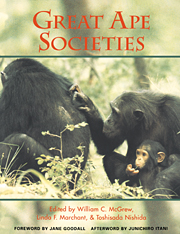Book contents
- Frontmatter
- Contents
- List of contributors
- Preface
- Foreword: conserving great apes
- Part I Apes overviewed
- Part II Social ecology
- Part III Social relations
- 8 Social grouping in Taï chimpanzees
- 9 Coalition strategies among adult male chimpanzees of the Mahale Mountains, Tanzania
- 10 Male rank order and copulation rate in a unit-group of bonobos at Wamba, Zaïre
- 11 Comparing copulations of chimpanzees and bonobos: do females exhibit proceptivity or receptivity?
- Part IV Minds
- Part V Apes compared
- Part VI Modeling ourselves
- Afterword: a new milestone in great ape research
- Appendix: great ape study sites
- Index
9 - Coalition strategies among adult male chimpanzees of the Mahale Mountains, Tanzania
Published online by Cambridge University Press: 04 August 2010
- Frontmatter
- Contents
- List of contributors
- Preface
- Foreword: conserving great apes
- Part I Apes overviewed
- Part II Social ecology
- Part III Social relations
- 8 Social grouping in Taï chimpanzees
- 9 Coalition strategies among adult male chimpanzees of the Mahale Mountains, Tanzania
- 10 Male rank order and copulation rate in a unit-group of bonobos at Wamba, Zaïre
- 11 Comparing copulations of chimpanzees and bonobos: do females exhibit proceptivity or receptivity?
- Part IV Minds
- Part V Apes compared
- Part VI Modeling ourselves
- Afterword: a new milestone in great ape research
- Appendix: great ape study sites
- Index
Summary
INTRODUCTION
Twenty years ago, at the time of the first Wenner-Gren Symposium on the great apes held in 1974, chimpanzee sociology was still in its infancy. People believed that unlike other non-human primates, great apes were peaceful creatures (e.g. Montagu, 1968; Goodall, 1973), although between-group relationships were known to be antagonistic, at least among the chimpanzees of Mahale (Nishida & Kawanaka, 1972). As examples of agonistic aid, high-ranking males reportedly ran to help their ‘friends’ against the latters' rivals (Goodall, 1971) and some old males were known to take refuge with particular dominant males against the other males' displays (Simpson, 1973). However, complex coalition tactics were not known. The subsequent 20 years have seen a major breakthrough in chimpanzee sociology and politics.
Coalition is defined as two or more individuals joining forces against one or more conspecific rivals. Now, there are many examples of coalitions in mammals and birds (Connor et al., 1992; Harcourt, 1992). However, coalitions among chimpanzees, adult males in particular, are exceptional for their frequency, complexity and flexibility. Some coalitions are so persistent that one may well call them alliances (e.g. Riss & Goodall, 1977; Goodall, 1986). On the other hand, adult males sometimes show extreme opportunism, changing sides from moment to moment (de Waal, 1982; Nishida, 1983; Uehara et al., 1994). Some coalitions are direct, while others are indirect (de Waal, 1982).
- Type
- Chapter
- Information
- Great Ape Societies , pp. 114 - 134Publisher: Cambridge University PressPrint publication year: 1996
- 109
- Cited by



